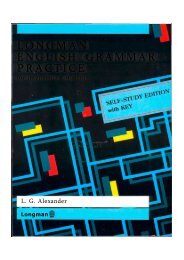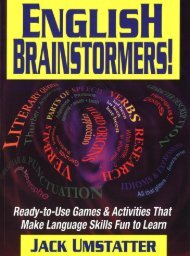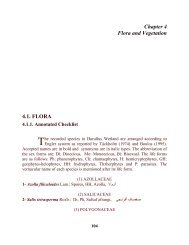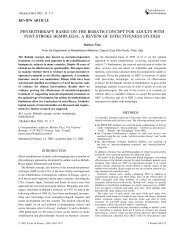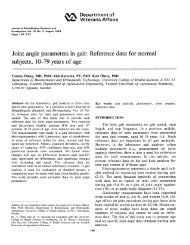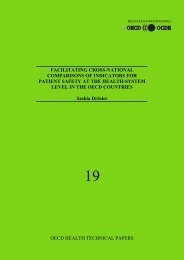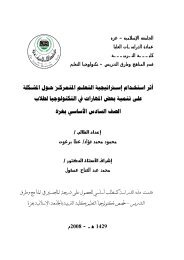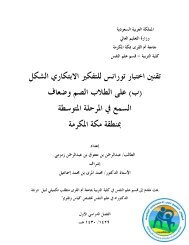Successful Ministry to the Retarded[ETowns] - Elmer Towns
Successful Ministry to the Retarded[ETowns] - Elmer Towns
Successful Ministry to the Retarded[ETowns] - Elmer Towns
- No tags were found...
Create successful ePaper yourself
Turn your PDF publications into a flip-book with our unique Google optimized e-Paper software.
general intellectual functioning, (2) which originates during <strong>the</strong> developmental period, and (3) isassociated with impairments in adaptive behavior." 18Definitions of mental retardation are developed along numerous lines of interest and inquiry,however, as our knowledge of this problem increases, <strong>the</strong> definitions of mental retardation willbecome more precise.The term feeblemindedness was common <strong>to</strong> American literature until approximately 1945, 19but <strong>to</strong>day it is rarely used in <strong>the</strong> United States because of its acquired undesirable connotations.To this point, no term o<strong>the</strong>r than mental retardation has been introduced; however, <strong>the</strong> conditionof retardation also has been identified by Savage as amentia; by Segar as imbecillites; by Vogel asFatuitas ingenii; by Linnaeus as morosis; by Fodere as demence inee; by Willis as stupiditas; byPinel as idiotism; by some English writers and by Esquirol and <strong>the</strong> majority of encyclopedias anddictionaries as idiocy. 20 Ano<strong>the</strong>r label given is mental deficiency, a term generally used in amanner synonymous with <strong>the</strong> AAMD concept of mental retardation. This type of definition,which differentiates retardation from deficiency, frequently appear in psychological and medicalliterature. 21CLASSIFICATION OF MENTAL RETARDATIONAfter considerable experience in applying <strong>the</strong> Binet-Simon Scale <strong>to</strong> institutionalized patients,Henry Goddard, 22 one of <strong>the</strong> first <strong>to</strong> introduce <strong>the</strong> work of Binet and Simon in<strong>to</strong> this country,recommended a system of classification according <strong>to</strong> test ratings as follows: idiots, those with amental age up <strong>to</strong> and including two years; imbeciles, those with a mental age of from three <strong>to</strong>seven years inclusive; morons, those with a mental age of from eight <strong>to</strong> twelve years. 23 Theseterms are now used infrequently and are nearly extinct. Today, as society becomes moreaccepting, we prefer <strong>to</strong> use terms with a more sophisticated connotation.The AAMD classification of measured intelligence is divided in<strong>to</strong> five categories: borderline,mild, moderate, severe, profound. The boundaries of each division will vary from test <strong>to</strong> test.The American Psychiatric Association organizes <strong>the</strong> subnormal in<strong>to</strong> three groups: mild,moderate, severe. The association considers mild <strong>to</strong> mean individuals with IQ in <strong>the</strong> 75 <strong>to</strong> 85range, moderate in <strong>the</strong> 50 <strong>to</strong> 75 range, and severe in <strong>the</strong> 0 <strong>to</strong> 50 range. 24The classification established by <strong>the</strong> American Psychiatric Association, although useful as aframe of reference, does not conform <strong>to</strong> current practices in <strong>the</strong> field. This classification tends <strong>to</strong>lead <strong>to</strong> oversimplification of something very complex and perplexing. Moreover, within eachlevel <strong>the</strong>re are wide differences of ability and potentiality, and overlapping is considerable betweenlevels. Recognizing <strong>the</strong>se fallacies, <strong>the</strong> National Association for <strong>Retarded</strong> Children suggests <strong>the</strong>following:marginal-dependent (educable)semi-dependent (trainable)dependent (<strong>to</strong>tal care ). 25The educable mentally retarded pupil has been defined as having IQ scores between 50 and 75and as having, or a prognosis that <strong>the</strong>y will have, learning difficulties in <strong>the</strong> regular grades. 26Children who are classified as trainable have been defined as having IQs from about 30 or 35 <strong>to</strong>50 or 55. This means that <strong>the</strong>y develop intellectually at about one-third <strong>to</strong> one-half <strong>the</strong> rate of <strong>the</strong>average child. 27 Cus<strong>to</strong>dial, or nursing, mentally defective children, are those who are almost


![Successful Ministry to the Retarded[ETowns] - Elmer Towns](https://img.yumpu.com/47721906/76/500x640/successful-ministry-to-the-retardedetowns-elmer-towns.jpg)

